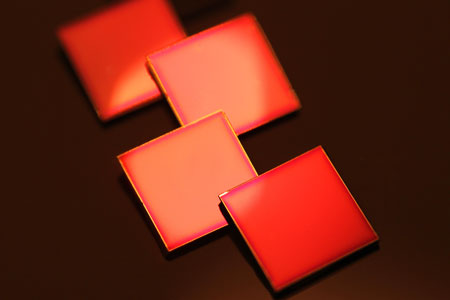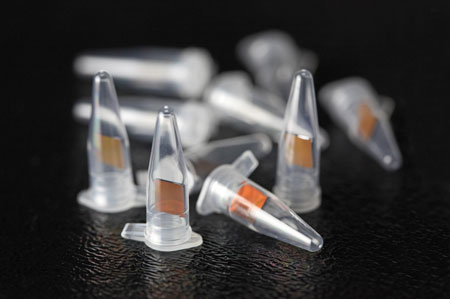Silmeco, which recently won the Danish journal Ingeniøren’s entrepreneur award, is a DTU spin-out. The company’s nanotechnological product can reveal the presence of extremely small volumes of a substance.
Explosives, narcotics, and toxic substances in foods are just three examples of cases where the identification of just a few molecules of a substance can be enough to set the alarm bells ringing.
Silmeco
This goes a long way to explaining why the young company Silmeco—which stems from a DTU invention—is attracting plenty of attention for SERStrate, its nanotechnological snitch. What is more, the product is priced at a level far below what customers would have to pay to identify the substances in question using traditional research equipment.
“New orders are rolling in every week, and we have already exported products to 20 countries. Most of our customers are based in the United States, but we also have clients in China, Germany, Great Britain, and Ireland,” says Per Elsted Hansen, CEO of Silmeco.
Photons as snitches
The company name, Silmeco, is a contraction of ‘Silicon Metal Coating’.
More specifically, the product SERStrate consists of a silicon nanostructure coated with a layer of gold or silver.
The product utilizes what is known as the ‘Raman effect’. When you transmit laser light into a sample, some of the light particles—the photons—will be reflected. The vast majority of these photons will have the same frequency and wavelength as before, but back in 1928, the Indian physicist C.V. Raman proved that a small proportion of the photons interact with the atoms in the sample in such a way that they change frequency and wavelength. The change reveals which atoms the sample contains and how they are chemically bound to other atoms.
 |
|
Those things that look like orange tiles are actually tiny, gold-plated chips with a nanostructure on their surface. The chips, which measure 4 x 4 mm, are used to perform quick and inexpensive Raman spectroscopy processes that can reveal the presence of substances such as melamine in milk powder.
|
Raman spectroscopy has been used in research laboratories for many years, but its use has been limited by the fact that it requires extremely accurate and expensive equipment— largely because only one out of every 10 million or so photons is affected by the Raman effect under normal circumstances. In 1974, however, researchers at the University of Southampton proved that it is possible to increase the number of Raman events significantly by placing the sample on a surface of silver that has been electrochemically roughened.
This effect, which was termed SERS (Surface Enhanced Raman Scattering), signalled the start of much more widespread use of Raman spectroscopy. Nevertheless, expensive equipment was still required, and it was still difficult to prepare nanostructured surfaces with the capacity to amplify the Raman effect. Up until now, that is, with the young Danish company making its triumphant entry onto the stage.
"New orders are rolling in every week, and we have already exported products to 20 countries. Most of our customers are based in the United States, but we also have clients in China, Germany, Great Britain, and Ireland."
Per Elsted Hansen, CEO of Silmeco
Smart process cuts costs
The new product SERStrate utilizes SERS—which thus provides the first three letters of the company name, while ‘strate’ refers to the fact that a substrate is involved.
SERStrate amplifies the familiar SERS effect even further by shaping the surface as a large number of silicon nano-columns coated in gold or silver. The shape and size of the columns has been chosen such that when a drop of a sample for examination is dripped onto the surface, the liquid will bend the columns in towards each other. This causes the columns to form electromagnetic hot spots, where the Raman effect is amplified in the extreme. This, in turn, makes it possible to detect molecules located in these areas. The overall result is that SERStrate produces a Raman signal 600 times stronger than the best SERS-substrates commercially available today.
At the same time, the product is much cheaper than other SERS-substrates thanks to a smart process invented by Professor Anja Boisen and Researcher Michael Stenbæk Schmidt from DTU Nanotech and Director Jörg Hübner from DTU Danchip.
While other SERS-substrates are the result of multiple production steps, where the surface is processed using photo-lithography or corresponding techniques, the Danish nanoresearchers decided to employ a two-step process based on what is known as Reactive Ion Etching. This involves using a plasma—an ionized gas that contains reactive ions—to shape the silicon surface. The reactive ions react with silicon atoms on the surface in a process that creates the silicon columns.
At the same time, silicon itself has a major practical advantage. A well-known source of error in SERS is that Raman signals are generated not by the sample, but by the substrate. Silicon, however, has a distinctive spectrum that is easy to separate from the substances that are usually the focus of attention. The same is not always the case with the other commercially available substrates.
 |
|
The glass tubes contain Silmeco’s small ‘nano-snitches’ that are sold to customers all over the world. They are used to determine precisely which molecules a sample contains. And they can reveal even tiny amounts of a substance.
|
Continued partnership with researchers
The method has been patented by DTU, and a licensing agreement grants Silmeco the right to utilize the patent.
In SERStrate, the individual silicon columns are typically 50–80 nanometres wide and 600–1,600 nanometres tall. The actual design of the product may vary, depending on the substance you wish to identify. One of the reasons for this is that the optical properties the columns take on when they lean in towards each other can be optimized for the molecule in which you are interested. In some cases, it may also be necessary to prepare the sample chemically to ensure that it will adsorb to the substrate.
“Customers occasionally ask whether we can help them continue the development work,” relates Per Elsted Hansen. “In such cases, we sometimes refer them to DTU’s chemical engineers. In this way, the project will continue to feature a high level of partnership with DTU researchers.”
Explosives and foods
The product is suitable for analysing both wet and gaseous samples, but not solids. In principle, there are no limits on the molecules it can be used to seek out.
“For practical reasons, however, we will be concentrating on marketing the product in association with specific groups of analyses, where we have already identified a considerable need. We are a small company, after all, so we cannot make a play for everything. Food safety is one of the areas in which we are particularly interested,” says Per Elsted Hansen, referencing cases of the toxic substance melamine appearing in milk powder in countries including China.
Other examples include ‘sniffing out’ explosives and drugs. While it is true that both these cases involve solids, the solids in question typically release some particles of themselves into the surrounding air. The amounts are tiny—but easily big enough for the ‘nano-snitch’ to pick up.
Article from DYNAMO no. 40, DTU's quarterly magazine in Danish.